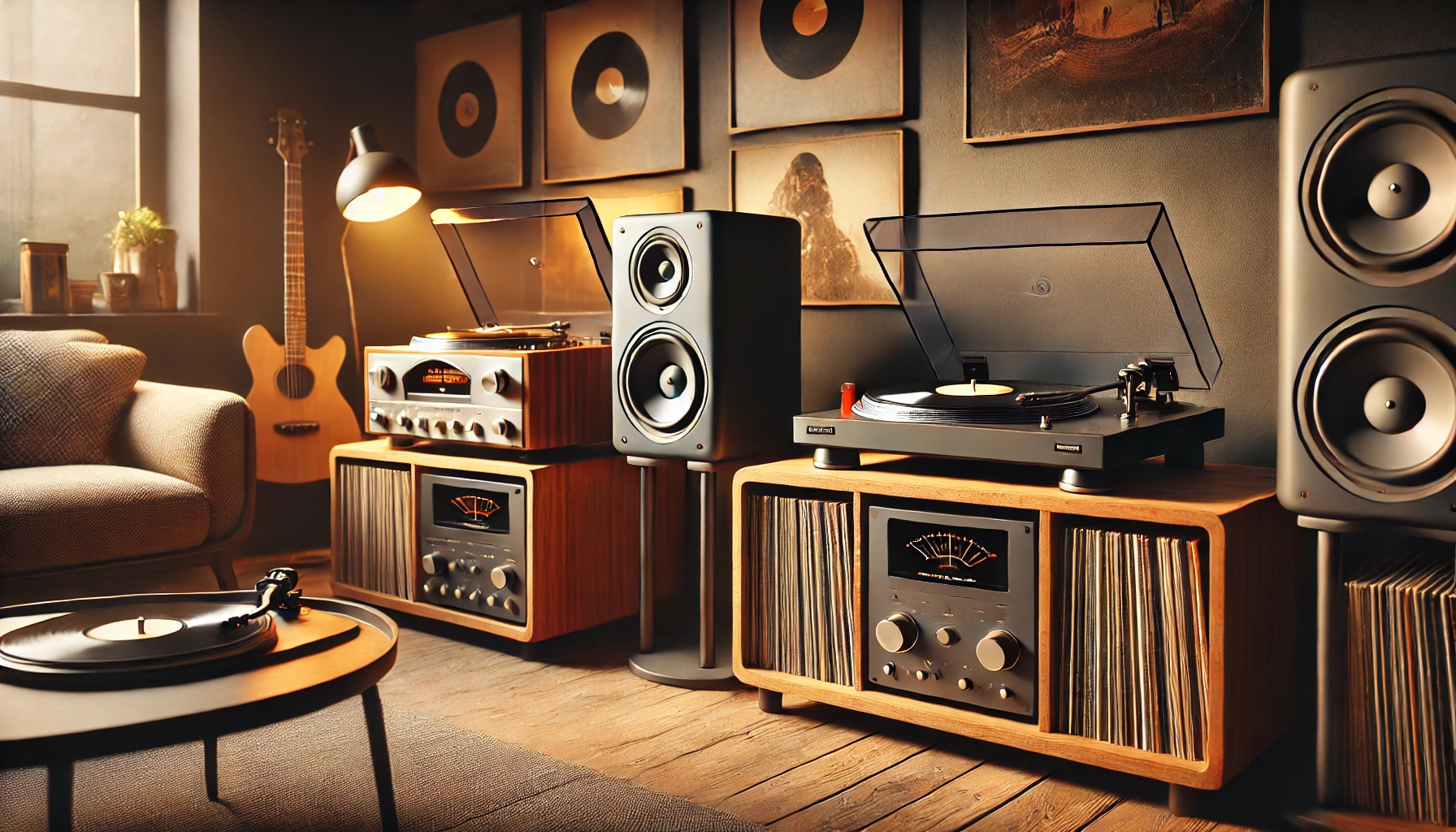Ah, the sweet, warm sound of vinyl! There’s nothing quite like it, right?
As I sit here, surrounded by stacks of records and the gentle hum of my audio setup, I can’t help but think about how confusing it can be for newcomers to the world of analog audio. One of the most common questions I get from friends just dipping their toes into this addictive hobby is, “What’s the difference between a turntable and a record player?” Well, buckle up, because we’re about to dive into the nitty-gritty of these vinyl-spinning marvels!
Turntable vs. Record Player: What’s the Difference?
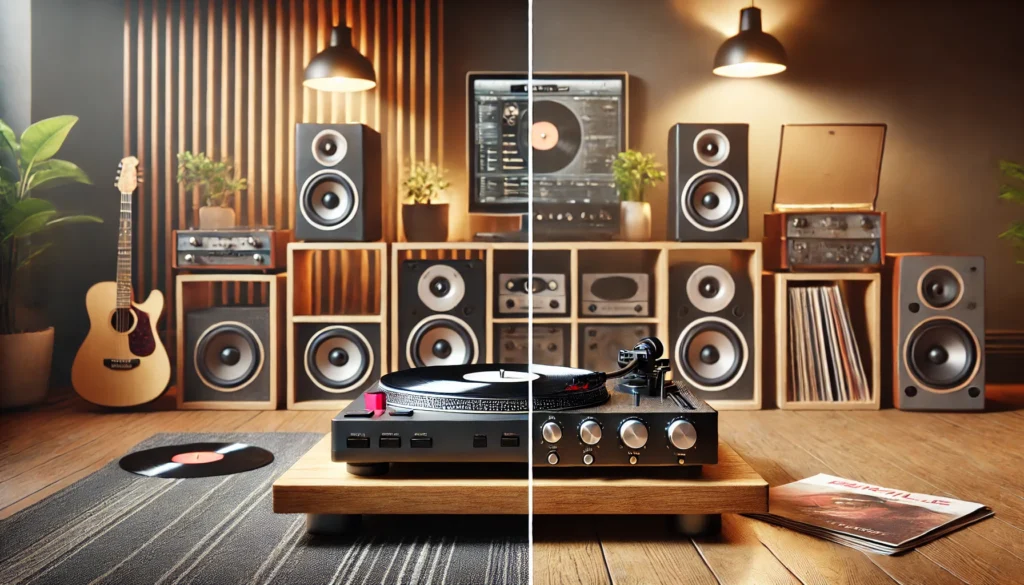
Alright, let’s break it down in simple terms. A turntable is the core component that actually spins the record and holds the tonearm and cartridge.
It’s like the engine of your vinyl setup. On the other hand, a record player is an all-in-one system that includes a turntable plus built-in speakers and sometimes even an amplifier. Think of it as the whole car, not just the engine.
Now, I’ve made the mistake of using these terms interchangeably in the past, and let me tell you, it led to some pretty confusing conversations with my audiophile buddies! But don’t worry, we’re going to explore this topic more deeply below, so you’ll be a vinyl vocab pro in no time.
What is a Turntable?
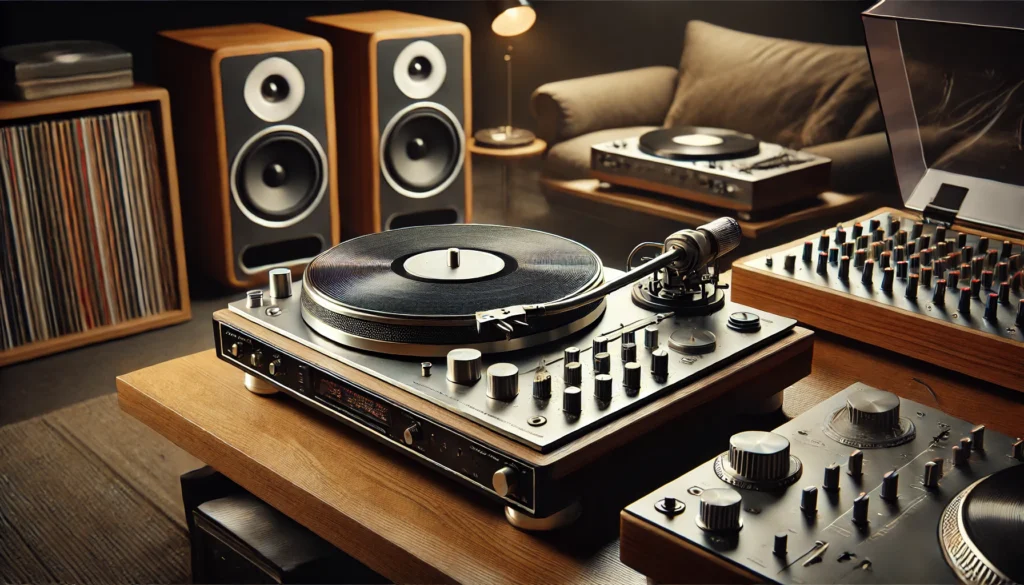
Let me tell you, when I first got into vinyl, I thought all turntables were created equal. Boy, was I wrong!
A turntable is the heart and soul of any serious vinyl setup. It’s the precision instrument that spins your records and extracts those sweet, sweet grooves.
Now, I remember the day I upgraded from my old hand-me-down record player to my first real turntable. It was like I was hearing my favorite albums for the first time all over again!
The clarity, the detail, the warmth – it was mind-blowing.
A typical turntable consists of a few key components:
- Platter: This is the circular platform where you place your record. It needs to spin at a consistent speed – 33 1/3, 45, or 78 RPM, depending on your record.
- Tonearm: This is the long, slender arm that holds the cartridge and needle. It’s responsible for tracking the grooves of your record accurately.
- Cartridge and Stylus: The cartridge houses the stylus (needle), which actually makes contact with the record grooves and converts the physical vibrations into electrical signals.
- Motor: This is what powers the platter’s rotation. There are two main types: belt drive and direct drive.
Each has its pros and cons, but that’s a whole other can of worms!
- Isolation System: This helps reduce vibrations from external sources that could interfere with sound quality. Trust me, you don’t want your tunes affected by every footstep in your house!
One of the biggest advantages of a standalone turntable is its upgradeability. You can swap out cartridges, upgrade the platter, or even change the tonearm to fine-tune your sound.
It’s like a never-ending quest for audio perfection – and let me tell you, it can get addictive!
But here’s the catch – a turntable by itself isn’t enough to actually play music. You’ll need to connect it to a phono preamp (sometimes built into amplifiers), an amplifier, and speakers.
It’s more complex, sure, but the payoff in sound quality can be huge.
I remember spending hours tweaking my first turntable setup, adjusting the tracking force, aligning the cartridge, and obsessing over every little detail. Was it overkill?
Maybe. But the first time I dropped the needle on a perfectly dialed-in system, I knew it was all worth it.
Turntables are the weapon of choice for serious audiophiles and vinyl enthusiasts. They offer superior sound quality, more precise playback, and the ability to upgrade and customize your setup over time.
However, they do require more knowledge and effort to set up and maintain properly.
If you’re the type who enjoys tinkering and wants the best possible sound from your vinyl collection, a turntable might be right up your alley. Just be warned – once you start down this path, you might find yourself constantly chasing that perfect sound!
What is a Record Player?

Ah, record players – they’re like the Swiss Army knives of the vinyl world! When I first started getting into records, I actually began with an old record player that belonged to my grandparents.
It was bulky, had a slightly wonky speed, but man, did it have charm!
A record player, unlike a turntable, is an all-in-one solution for playing vinyl. It typically includes:
- A turntable mechanism (similar to what we discussed earlier)
- A built-in phono preamp
- An amplifier
- Speakers
Basically, it’s everything you need to start spinning records, all in one convenient package. Just plug it in, pop on a record, and you’re good to go!
Now, I’ll be honest – when I first got that hand-me-down record player, I thought I was hot stuff. I’d invite friends over, show off my growing vinyl collection, and act like I was some kind of audio connoisseur.
Little did I know, I had barely scratched the surface of what vinyl playback could offer!
But you know what? That old record player served its purpose perfectly.
It got me hooked on the warm, rich sound of vinyl and the tactile experience of physically handling my music.
The biggest advantage of a record player is its simplicity and convenience. There’s no need to worry about matching components or setting up a complex system.
It’s perfect for casual listeners or those just getting into vinyl.
I remember when my cousin wanted to start listening to some old jazz records she’d inherited. She was intimidated by all the talk of cartridges, preamps, and whatnot.
I pointed her towards a decent entry-level record player, and she was over the moon. Sometimes, simpler really is better!
Record players also tend to be more compact and portable than a full turntable setup. Some even come in cute suitcase designs – perfect for those impromptu vinyl listening parties!
(Just be careful with those – some can be pretty rough on your records if you’re not careful.)
However, there are some trade-offs with record players:
- Sound Quality: While they can sound good, especially at the higher end, they generally don’t match the audio quality of a well-set-up component turntable system.
- Upgradability: Most record players are closed systems. You can’t upgrade the cartridge or other components like you can with a turntable.
- Durability: The all-in-one nature means if one part breaks, the whole system might need replacing.
- Vibration Issues: Having the speakers in the same unit as the turntable can sometimes cause feedback or vibration problems.
Despite these limitations, record players have their place. They’re great for casual listening, for those who want a simple, hassle-free way to enjoy vinyl, or as a starting point for new collectors.
I still have a soft spot for that old record player that started my vinyl journey. Sure, it couldn’t hold a candle to my current setup in terms of sound quality, but the memories of discovering new music on that thing?
Absolutely priceless.
Comparing Turntables and Record Players
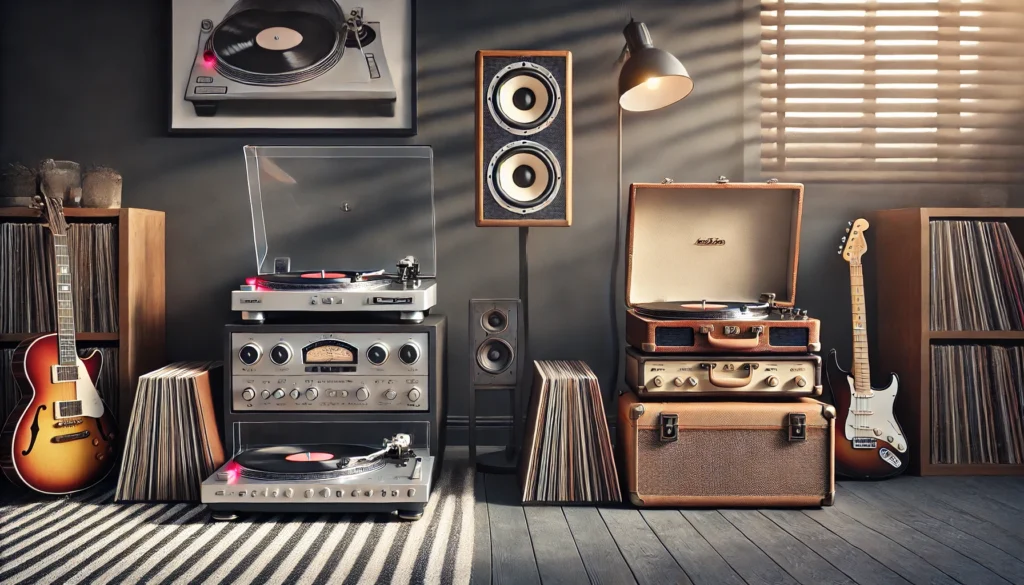
Alright, let’s get down to brass tacks and compare these vinyl-spinning contenders! Having used both extensively (and made plenty of rookie mistakes along the way), I can give you the real scoop on how turntables and record players stack up.
In my experience, this is where turntables really shine when it comes to sound quality. A well-set-up turntable connected to quality components can deliver audio that’ll make your jaw drop.
I remember the first time I heard a high-end turntable at an audio show – it was like hearing my favorite albums for the first time all over again!
Record players, on the other hand, can sound good, but they’re often limited by their built-in components. Don’t get me wrong, some high-end all-in-one systems can sound fantastic, but generally, they can’t match the clarity and detail of a dedicated turntable setup.
If you’re anything like me and love to tinker, turntables are your playground when it comes to customization. You can swap cartridges, upgrade platters, experiment with different phono preamps – the sky’s the limit!
I once spent an entire weekend trying different cartridge and preamp combinations, much to my partner’s amusement (or was it exasperation?).
Record players are more of a “what you see is what you get” situation. While some might allow for cartridge upgrades, most are closed systems without much room for customization.
Here’s where record players take the lead in terms of ease of use. They’re plug-and-play – just set it up, pop on a record, and you’re good to go.
Perfect for those days when you just want to listen to music without fussing with settings.
Turntables require more setup and additional components. I remember spending hours trying to perfectly align my first cartridge – talk about a test of patience!
Record players win on compactness when it comes to space requirements. Everything’s in one unit, which is great for small spaces or if you want to move your setup around.
A full turntable system with separate amp and speakers will take up more room. But hey, it gives you an excuse to show off your gear, right?
You can find both turntables and record players at various price points. Entry-level record players are often cheaper to get started with since you don’t need to buy separate components.
However, turntables offer more flexibility in budgeting. You can start with a basic setup and upgrade components over time.
I started with a modest turntable and slowly built up my system as my budget (and obsession) grew.
Quality turntables can last for decades with proper care when it comes to longevity. I’ve seen vintage turntables from the 70s that still sound amazing!
Record players, especially at the lower end, might not have the same lifespan. If one component fails, you might need to replace the entire unit.
Turntables, especially high-end ones, are designed to minimize vibrations for cleaner playback when it comes to vibration handling. Some even have elaborate suspension systems.
Record players can be more prone to vibration issues since the speakers are in the same unit as the turntable. I learned this the hard way when I cranked up the volume on my first all-in-one player and got a nasty feedback loop!
In the end, the choice between a turntable and a record player comes down to your priorities. Do you want the best possible sound quality and don’t mind a bit of complexity?
Go for a turntable. Want something simple and convenient to get started with vinyl?
A record player might be your best bet.
Just remember, whichever you choose, the most important thing is enjoying the music. After all, that’s what this vinyl journey is all about!
Which One Should You Choose?
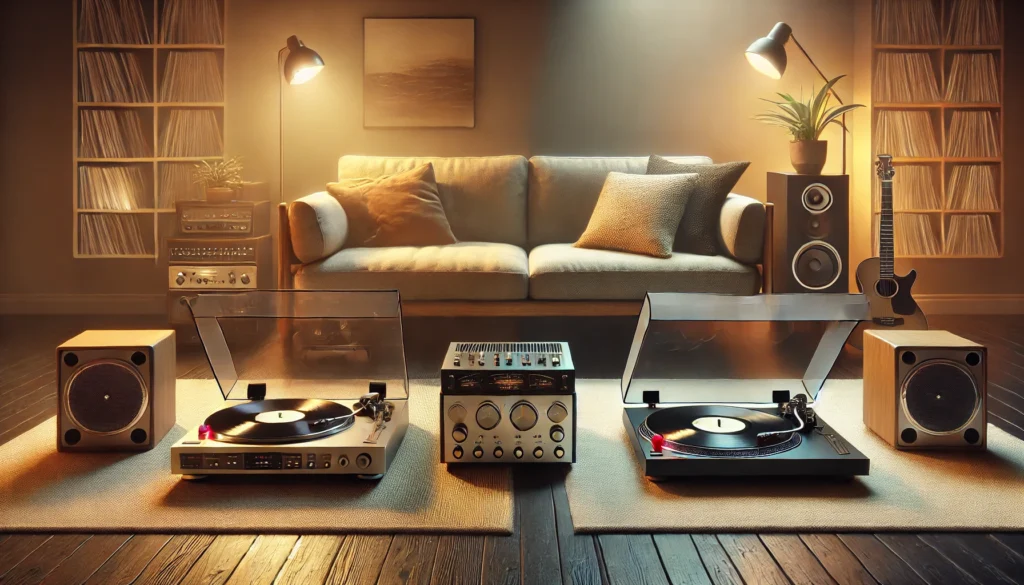
Alright, decision time! After years of experimenting with both turntables and record players (and yes, making plenty of questionable purchases along the way), I’ve got some insights to help you choose the right option for your vinyl journey.
First things first, ask yourself: what kind of listener are you?
If you’re just dipping your toes into the vinyl world, or if you prefer a no-fuss listening experience, a record player might be your best bet. I remember when my sister wanted to start listening to vinyl – she’s not much of a tech person, so I recommended a decent all-in-one record player.
She loves it! It’s simple, compact, and lets her enjoy her small but growing record collection without any hassle.
On the other hand, if you find yourself obsessing over sound quality and dreaming about upgrading your audio gear, a turntable is probably calling your name. That was me about a decade ago – I started with a basic turntable, and before I knew it, I was down the rabbit hole of cartridge alignments and phono preamp comparisons!
For those living in a small apartment or dorm room, a record player’s compact, all-in-one design might be a lifesaver. I used a record player during my college years, and it was perfect for my tiny dorm room.
But if you’re a vintage enthusiast who loves the idea of hunting for and restoring classic audio gear, go for a turntable. There’s something special about bringing a decades-old turntable back to life.
Just be prepared for some frustration along the way – I once spent weeks trying to fix a ground hum on a vintage table!
If you think you might want to improve your system over time, start with a turntable. You can upgrade components piece by piece as your budget allows.
Trust me, it’s a slippery slope – you start with a cartridge upgrade, and before you know it, you’re considering a second mortgage for that limited edition audiophile pressing! However, if the idea of setting up and maintaining a complex system sounds like a chore rather than a joy, stick with a record player.
Sometimes you just want to listen to music without worrying about tracking force and anti-skate settings.
Now, let’s talk budget. If you’re on a tight budget, you can find decent record players for under $100, while good entry-level turntables usually start around $200-$300 (not including additional necessary components).
With a mid-range budget, you’ve got options with both. Quality record players can be found in the $300-$500 range, while that same budget can get you a nice turntable (though you’ll need to factor in costs for a preamp, amp, and speakers).
If money is no object, high-end options exist for both, but turntables have a much higher ceiling in terms of quality and price. Be warned – this hobby can get expensive fast!
My personal recommendation? If you’re serious about getting into vinyl and think this might become more than a passing interest, start with a decent entry-level turntable.
Yes, it’s a bit more work upfront, but it gives you room to grow and upgrade. I started this way, and while there were definitely some frustrating moments (like the time I accidentally dropped my cartridge and had a minor meltdown), the journey has been incredibly rewarding.
But here’s the most important thing: don’t let perfectionism or gear obsession get in the way of enjoying the music. Whether you’re spinning records on a high-end turntable or a budget-friendly record player, what matters most is the joy of dropping the needle and immersing yourself in the warm, rich sound of vinyl.
After all, isn’t that why we fell in love with records in the first place?
Maintaining Your Vinyl Listening Equipment
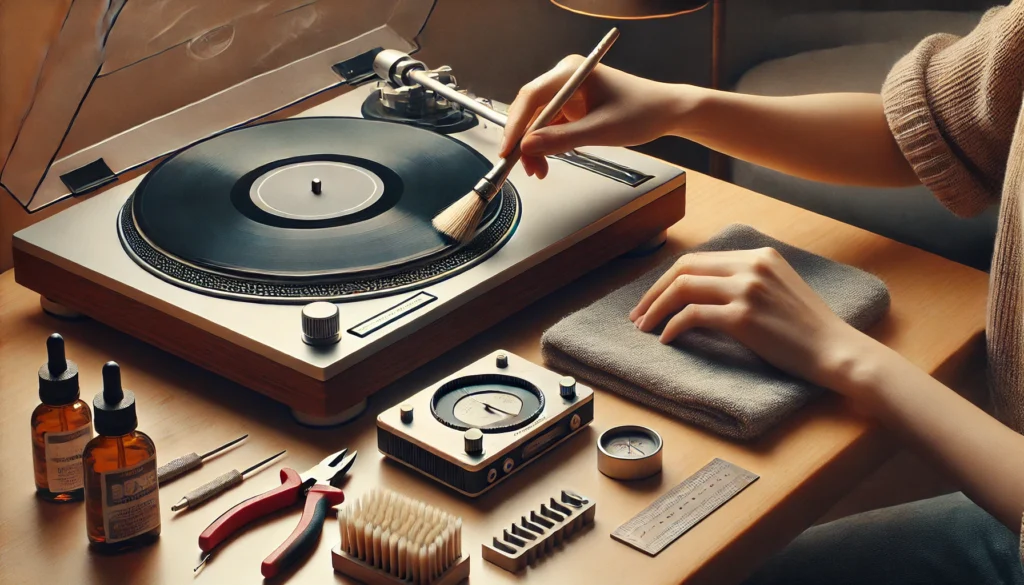
Whether you’ve chosen a turntable or a record player, proper maintenance is key to ensuring your vinyl listening experience remains top-notch. Trust me, I’ve learned this lesson the hard way – nothing’s worse than discovering your favorite record sounds like it’s being played underwater because you neglected your equipment!
Let’s start with turntables. These precision instruments require a bit more TLC, but it’s worth it for the superior sound quality.
First and foremost, keep your turntable clean and dust-free. I make it a habit to gently dust my turntable with a soft, anti-static brush before each listening session.
It only takes a few seconds, but it makes a world of difference.
One of the most critical aspects of turntable maintenance is cartridge alignment and tracking force. I remember the first time I tried to align my cartridge – it felt like I was performing microsurgery!
But once I got the hang of it, I realized how much it improved my sound quality. Invest in a good alignment protractor and a digital tracking force gauge.
Trust me, your records (and ears) will thank you.
Don’t forget about your stylus (needle)! A dirty or worn stylus can not only sound terrible but can actually damage your records.
I learned this the hard way when I noticed some of my favorite albums starting to sound distorted. Turns out, my stylus was well past its prime.
Now, I clean my stylus with a specialized brush after every few plays and replace it according to the manufacturer’s recommendations.
For belt-drive turntables, check your belt periodically. If it’s looking stretched out or worn, it’s time for a replacement.
I once ignored a slipping belt, thinking it wasn’t a big deal. Let’s just say Radiohead’s “OK Computer” sounded more like “Not OK Computer” until I fixed it!
Now, onto record players. While they’re generally lower maintenance than turntables, they still need some care.
Keep the exterior clean and dust-free, just like with a turntable. Pay special attention to the tonearm and cartridge area – dust buildup here can affect your sound quality.
Many record players have ceramic cartridges, which are more durable than the moving magnet or moving coil cartridges found in most turntables. However, they can still wear out over time.
Conclusion
Whew! We’ve come a long way on this vinyl journey, haven’t we? From breaking down the differences between turntables and record players to diving into maintenance tips, we’ve covered a lot of ground.
But you know what? This is just the beginning of your adventure in the world of vinyl.
As we wrap up, let’s recap the key differences between turntables and record players. Turntables offer superior sound quality and customization options but require more setup and additional components.
Record players, on the other hand, provide an all-in-one solution that’s perfect for beginners or those who prefer simplicity.
But here’s the thing – there’s no universally “right” choice. The best option for you depends on your personal preferences, budget, and how deep you want to dive into the vinyl hobby.
Whether you choose a high-end turntable or a budget-friendly record player, what matters most is that you’re enjoying the music.
I remember when I first started out, I was so caught up in trying to have the “perfect” setup that I almost forgot why I got into vinyl in the first place – the music! Don’t make the same mistake I did.
Choose the option that fits your lifestyle and brings you joy.
If you go the turntable route, embrace the learning curve. There’s something incredibly satisfying about fine-tuning your system and hearing the improvements in sound quality.
And if you opt for a record player, revel in the simplicity and convenience. There’s a certain charm in being able to start listening to your favorite album with just the flip of a switch.
Remember, vinyl is more than just a way to listen to music – it’s an experience. It’s the ritual of carefully removing a record from its sleeve, gently placing it on the platter, and watching the stylus make contact with those grooves.
It’s about rediscovering albums you thought you knew by heart and hearing details you never noticed before.
So, whether you’re team turntable or team record player, the most important thing is to enjoy the journey. Explore new music, revisit old favorites, and don’t be afraid to make a few mistakes along the way – that’s all part of the fun!
And hey, why not share your experiences? Join online forums, visit local record stores, or invite friends over for listening sessions.
The vinyl community is full of passionate, knowledgeable people who are always happy to share tips and recommendations.
As for me, my vinyl journey is far from over. There’s always a new album to discover, a new piece of gear to try, or a new technique to perfect.
And you know what? I wouldn’t have it any other way.
So, what are you waiting for? Whether you’re setting up your first turntable or dusting off that old record player, it’s time to drop the needle and let the music play.
Happy listening, and welcome to the wonderful world of vinyl!
